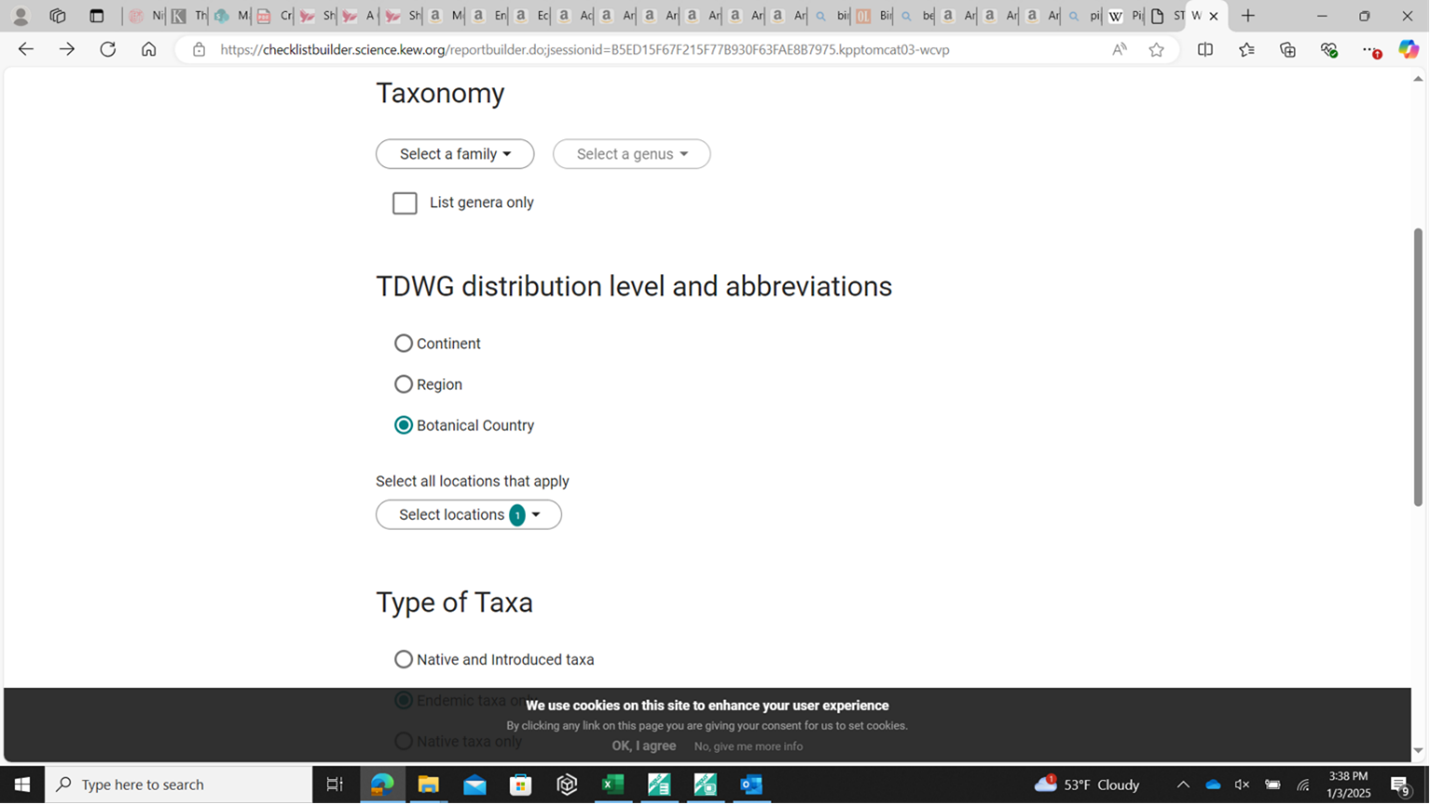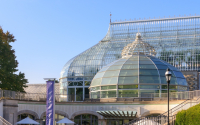Challenge D
Welcome to the elementary school challenge page for Challenge D of the Fairchild Challenge! Read below to find challenge information, entry requirements, resources and more for the challenge.
Challenge D: Botanical Sculptures
Title: "Bountiful Bouquets: Blossoms of the Jungle"
For individuals or Groups | Maximum points: 200
Due Date: Fri., March 21 by 5 p.m.
Your Challenge:
This challenge invites you to discover the fascinating world of Panama’s native plants while using your creativity to make a meaningful and sustainable project. This winter, Phipps Conservatory is transitioning out of Tropical Forest Hawaii and into Tropical Forest Panama! Panama is home to an incredibly rich variety of plants due to its diverse climates and ecosystems. Your task is to design and create a 3D “bouquet” made of at least three flowering plants that are endemic or native to Panama—meaning they are only found in or originated in this country, respectively. But, instead of using real flowers, your 3D bouquet should be made entirely from recycled or reused materials.
Along with your bouquet, write a brief description of the plants you've chosen. Take time to research each one, exploring its native habitat, special features, and why it is important to Panama’s ecosystem. Consider how these plants contribute to the environment, from supporting local wildlife to maintaining the balance of the ecosystem. This research will help you better appreciate the importance of protecting Panama’s natural heritage. Lastly, dedicate your bouquet to a teacher or friend. Your project will not only showcase your artistic skills but also highlight your understanding of Panama’s incredible biodiversity.
Materials for the sculptures cannot be purchased new; they must be found at home/school, recycled, or purchased from a secondhand store – we highly recommend visiting the Pittsburgh Center for Creative Reuse for a wide variety of sculpture-crafting materials! (Please do not use food or living materials). Along with each sculpture, please submit a photo of the designer(s) and a description. The description should include:
- A bio for each designer (name, grade, school, and tell us a little bit about yourself and your interests)
- The materials you used, and where they came from
- A brief summary of the plants included in your bouquet (are they native, endemic? What are their scientific names? Where in Panama are they located? Do they have any unique or interesting traits?) 50-250 words.
- A dedication
Select sculptures from this challenge will be featured in Phipps’ 2025 summer show – Jungle Quest. Therefore, each sculpture MUST be original, and include a photo and description. A very limited number of well-made sculptures will be displayed.
Entry Requirements: Deliver to the high school programs coordinator at Phipps in person or via certified mail (electronic submission is not accepted):
- Challenge Entry Form
- A “bouquet” sculpture created using found, recycled, or thrifted materials (NO LIVE PLANT MATERIAL OR GLITTER)
- Sculptures should be creative, well-constructed, and COLORFUL!
- Sculptures must be 3D and no larger than 2ft by 2ft and free standing
- Descriptions including designers’ bios, inspirations, materials and their source, and how it was constructed
- Include the school name and the participating students’ names.
School Submits: Challenge Entry Form, 3 sculptures MAXIMUM, photo of designer(s), description/bios.
Address:
Phipps Conservatory and Botanical Gardens
The Fairchild Challenge c/o Alyssa Mulé
One Schenley Park
Pittsburgh, PA 15213
Resources: The following list of online resources may be used when preparing your entry:
- KIDS NATIONAL GEOGRAPHIC: Panama
- Flora of Panama on JSTOR
- Discover AMIGOS: The Orchids of Panama - Amigos de las Americas
- Search for ALL plants: STRI Research Portal Inventory Projects
- Plants of the World Online | Kew Science
- Then select Data -> build a checklist.
You do not have to specify a family or genus, but you will need to specify the botanical country (Panama):

The type of taxa you are interested on (endemic only) and how you want the information displayed:

Then hit create checklist and wait a bit while it builds the checklist. You can then use the species names you find in there to do specific searches in plants of the world.
- 3.1.K.A5 Observe and describe structures and behaviors of a variety of common animals.
- 3.1.K.B1 Observe and describe how young animals resemble their parents and other animals of the same kind.
- 3.1.K.C3 CONSTANCY AND CHANGE Describe changes that occur as a result of climate.
- 3.2.K.A3 Describe the way matter can change.
- 3.2.K.B3 Describe how temperature can affect the body.
- 3.2.K.B6 ENERGY Recognize that light from the sun is an important source of energy for living and nonliving systems and some source of energy is needed for all organisms to stay alive and grow.
- 4.1.K.A Identify the similarities and differences of living and non-living things within the immediate and surrounding environment.
- 4.1.K.D Observe and describe what happens to living things when needs are met.
- 4.2.K.C Identify that there are living and nonliving components in an aquatic habitat.
- 3.1.1.A2 Investigate the dependence of living things on the sun’s energy, water, food/nutrients, air, living space, and shelter.
- 3.1.1.C3 CONSTANCY AND CHANGE Describe changes that occur as a result of habitat.
- 3.3.1.A4 Identify and describe types of fresh and salt-water bodies (ocean, rivers, lakes, ponds).
- 4.5.1.C Describe how pollution affects the health of a habitat.
- 3.1.2.C2 Explain that living things can only survive if their needs are being met.
- 3.1.2.C3 CONSTANCY AND CHANGE Describe some plants and animals that once lived on Earth, (e.g., dinosaurs) but cannot be found anymore. Compare them to now living things that resemble them in some way (e.g. lizards and birds).
- 4.1.2.A Describe how a plant or an animal is dependent on living and nonliving things in an aquatic habitat.
- 4.1.2.D Identify differences in living things (color, shape, size, etc.) and describe how adaptations are important for survival.
- 4.1.2.E Identify how living things survive changes in their environment.
- 4.2.2.C Identify and describe the basic needs of plants and animals in an aquatic ecosystem.
- 4.4.2.C Examine life cycles of plants and animals in an aquatic habitat.
- 4.5.2.C Identify how people can reduce pollution.
- 3.1.3.A2 Describe the basic needs of living things and their dependence on light, food, air, water, and shelter.
- 3.1.3.B5 PATTERNS Identify characteristics that appear in both parents and offspring.
- 3.1.3.C2 Describe animal characteristics that are necessary for survival.
- 3.1.3.C3 CONSTANCY AND CHANGE Recognize that fossils provide us with information about living things that inhabited the Earth long ago
- 3.2.3.B3 Explore temperature changes that result from the addition or removal of heat.
- 4.1.3.D Identify organisms that are dependent on one another in a given ecosystem.
- Define habitat and explain how a change in habitat affects an organism.
- 4.1.3.E Identify changes in the environment over time.
- 3.1.4.A5 Describe common functions living things share to help them function in a specific environment.
- 3.1.4.B5 PATTERNS Identify observable patterns in the physical characteristics of plants or groups of animals.
- 3.1.4.CI Identify different characteristics of plants and animals that help some populations survive and reproduce in greater numbers. Describe how environmental changes can cause extinction in plants and animals.
- 3.1.4.C2 Describe plant and animal adaptations that are important to survival.
- 3.1.4.C3 CONSTANCY AND CHANGE Compare fossils to one another and to currently living organisms according to their anatomical similarities and differences.
- 4.1.4.D Explain how specific adaptations can help organisms survive in their environment.
- 3.1.5.B1 Differentiate between inherited and acquired characteristics of plants and animals.
- 3.1.5.C2 Give examples of how inherited characteristics (e.g., shape of beak, length of neck, location of eyes, shape of teeth) may change over time as adaptations to changes in the environment that enable organisms to survive.
- 4.2.5.C Identify physical, chemical, and biological factors that affect water quality.


